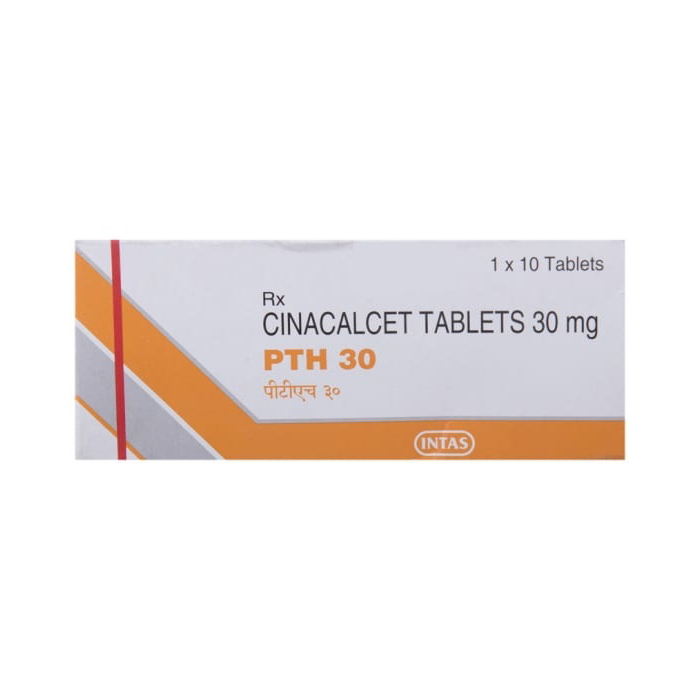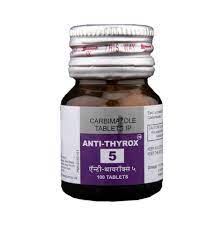PTH 30mg Tablet
$45.00 $34.00
PTH 30mg Tablet 10S

Description
PTH 30MG contains cinacalcet which belongs to a group of medicines called calcimimetic agent that increases the sensitivity of the calcium-sensing receptor to activation by extracellular calcium. It treats problem with the organs called parathyroid glands. The parathyroids are four small glands in the neck, near thyroid gland, that produce the parathyroid hormone (PTH). Hyperparathyroidism (HPT) is a condition where the parathyroid gland may become overactive and make too much PTH. In this condition the calcium stored in the bones move into the blood leading to hypercalcemia (too much calcium in the blood).
Secondary hyperparathyroidism (SHPT) describes an alteration in bone and mineral metabolism that occurs as a direct result of chronic kidney disease (CKD). The parathyroid gland is the central organ responsible for regulating these adaptive responses leading to secondary hyperparathyroidism. Parathyroid hormone helps prevent low calcium levels by acting on the bones, intestine, and kidneys. PTH 30MG works by controlling levels of the parathyroid hormone (PTH), calcium and phosphorous in body.
Children under the age 18 with parathyroid cancer or primary hyperparathyroidism must not take this medicine. Do not drive or operate machines, if you experience side effects such as dizziness and seizures. If you are pregnant or breast-feeding, think you may be pregnant or planning to have a baby, ask your doctor for advice before taking this medicine. The usual starting dose for this medicine in adults is 30 mg twice per day or as directed by your physician. Swallow the medicine whole with plenty of water. The most common side effects are nausea, vomiting, dizziness, rash, muscle pain, loss of appetite, headache, etc.
USES OF PTH 30MG:
Secondary hyperparathyroidism (HPT) in patients with chronic kidney disease (CKD) on dialysis
Hypercalcemia in patients with Parathyroid carcinoma and primary hyperparathyroidism (HPT)
HOW PTH 30MG WORKS:
PTH 30MG works by controlling levels of the parathyroid hormone (PTH), calcium and phosphorous in body.
DIRECTIONS FOR USE:
The usual starting dose for this medicine in adults is 30 mg twice per day or as prescribed by your doctor. Swallow the medicine whole with plenty of water.
SIDE EFFECTS OF PTH 30MG:
SERIOUS
Numbness or tingling around mouth, muscle aches or cramps and seizures. These may be signs of low calcium levels (hypocalcaemia)
Swelling of face, lips, mouth, tongue or throat which may cause by difficulty in swallowing or breathing (angioedema)
COMMON
Dizziness, headache
Nausea or vomiting
Constipation
Feeling weak
Loss (anorexia) or decrease of appetite
Muscle pain (myalgia)
Weakness (asthenia)
Rash
Reduced testosterone levels
High potassium levels in the blood (hyperkalaemia)
Allergic reactions (hypersensitivity)
Diarrhea
Indigestion
HOW TO MANAGE SIDE EFFECTS:
Constipation:
Eat fiber rich foods such as fresh fruit, vegetables and cereals, and drink plenty of water. Exercise more regularly.
Nausea and vomiting:
Keep try taking this medicine with, or just after, a meal or snack and stick to simple meals and do not eat rich or spicy food.
Headache:
Apply hot or cold-water bag on your head. Take rest in a quiet and dark room. Drink tea or coffee.
INTERACTIONS:
Talk to your doctor if you are taking medicines used to:
Treat the skin and fungal infections
Treat the bacterial infections (telithromycin, rifampicin and ciprofloxacin)
Treat HIV infection and AIDS (ritonavir)
Treat depression (fluvoxamine)
Treat depression
Relieve cough (dextromethorphan)
Treat the changes in heart rate (flecainide and propafenone)
Treat high blood pressure
SYNOPSIS:
Drug : Cinacalcet
Pharmacological Category : Calcimimetics
Therapeutic Indication : Hyperparathyroidism
Dosage Forms : Tablet
MORE INFORMATION:
Store below 20-25°C and keep out of reach of children.
PRODUCT INTRODUCTION
Pth 30 Tablet may be used alone or in combination with other medicines. It can be taken with or without food. It should be taken exactly as prescribed by your doctor. Your doctor will decide the dose and how often you should take them. You should take this medicine regularly to get the most benefit from it. Do not stop taking the medicine even if you feel better unless the doctor tells you so.
The most common side effects of this medicine are nausea and vomiting. It may also cause other side effects such as headaches, diarrhea, rash, and muscle pain. Let your doctor know if any of these side effects do not go away with time or get worse, or if you experienced any other symptoms which you think are caused by this medicine.
Before using this medicine, inform your doctor if you have any problems with your heart, liver, or ever had seizures (fits or convulsions). You should also tell your doctor all the other medications you are taking. If you have low levels of calcium in your body, you should not take this medicine. Your doctor may monitor your blood calcium level while on treatment with this medicine. Pregnant and breastfeeding mothers should ask their doctors’ advice before taking this medicine.
USES OF PTH TABLET
- Treatment of High calcium levels in the blood
- Treatment of Hyperparathyroidism
BENEFITS OF PTH TABLET
In Treatment of High calcium levels in the blood
Being immobile makes hypercalcemia worse. Whenever possible you should take regular exercise, especially weight-bearing exercise. Do not take calcium or vitamin D3 supplements and try to decrease your intake of these in your diet.
In Treatment of Hyperparathyroidism
SIDE EFFECTS OF PTH TABLET
Common side effects of Pth
- Vomiting
- Nausea
- Rash
- Headache
- Muscle pain
- Diarrhea
HOW TO USE PTH TABLET
HOW PTH TABLET WORKS
SAFETY ADVICE

Alcohol

Pregnancy

Breast feeding

Driving
Dizziness and seizures have been reported by patients taking Pth 30 Tablet. This may affect your driving ability.

Kidney

Liver
FAQs ABOUT PTH 30MG:
Q: Can PTH 30MG be used in pregnant women?
A: No. It is not recommended for use in the pregnant women. Consult your doctor before taking.
Q: Does PTH 30MG cause hypocalcemia?
A: It can cause acute, severe and symptomatic hypocalcaemia in susceptible patients, possibly those with prolonged high bone turnover states or those not receiving VDRA therapy.
Be the first to review “PTH 30mg Tablet” Cancel reply
Related products
Hyperthyroidism
Hyperthyroidism
Hyperthyroidism
Hyperthyroidism
Hyperthyroidism
Hyperthyroidism
Hyperthyroidism











Reviews
There are no reviews yet.